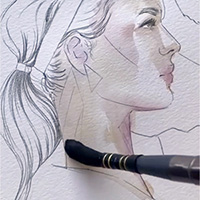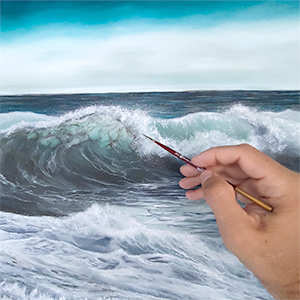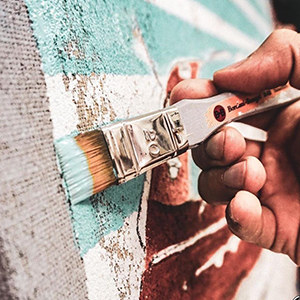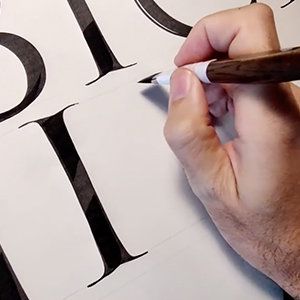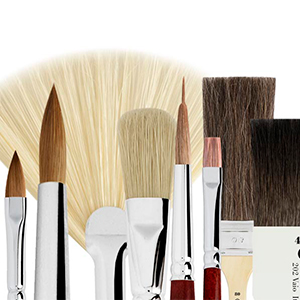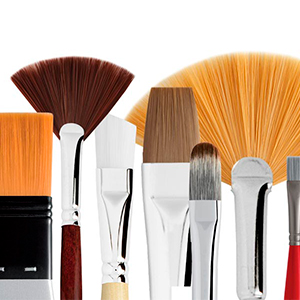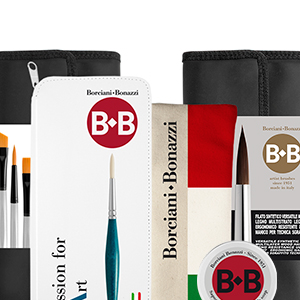Tre cose da sapere per iniziare a dipingere con acrilico
3 things to know before starting to paint with acrylic
Acrylic painting is the latest in the evolution of Fine Arts.
It was created industrially in the wake of the experiments of the artists of the American POP ART, who used the colors of whitewashing mixed with glue and various materials, uses the mix of pigments and acrylic resins to create the color matter!
Opaque or transparent, with bright tones that tend to darken when drying, water-based acrylic paint is the most used in the world of painting and decoration, for its characteristics of fast drying, elasticity and permanence.
Little appreciated by purists of color until the twentieth century, for the covering effect and sometimes slightly plastic finish, called "poor painting", has evolved over the years with the research of color producing industries, giving life to intense and brilliant colors that with appropriate medium have little to envy the more traditional oil painting!
The resins have been refined, losing the yellowing part of the drying, becoming more transparent and thus giving the color a greater and shining brightness.
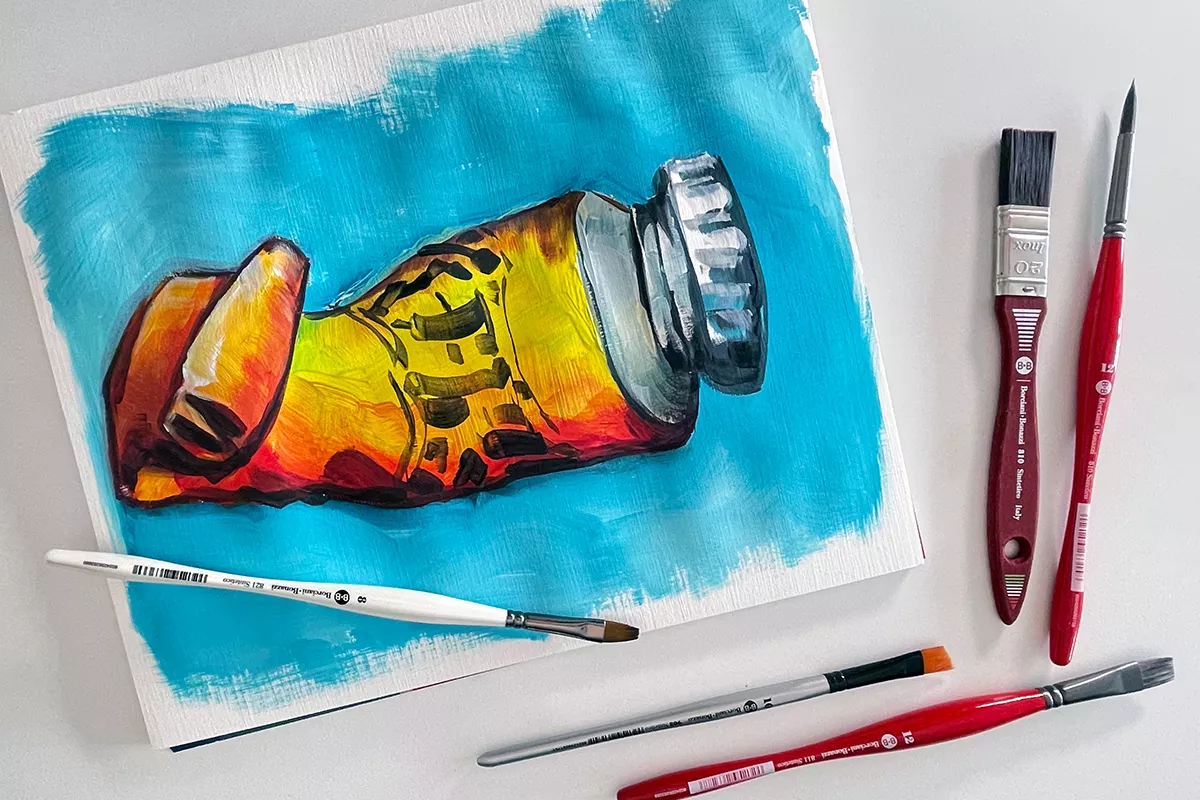
Painting with acrylic: historical notes
Acrylic paints were created in 1915 by a German pharmacist and chemist, Otto Röhm.
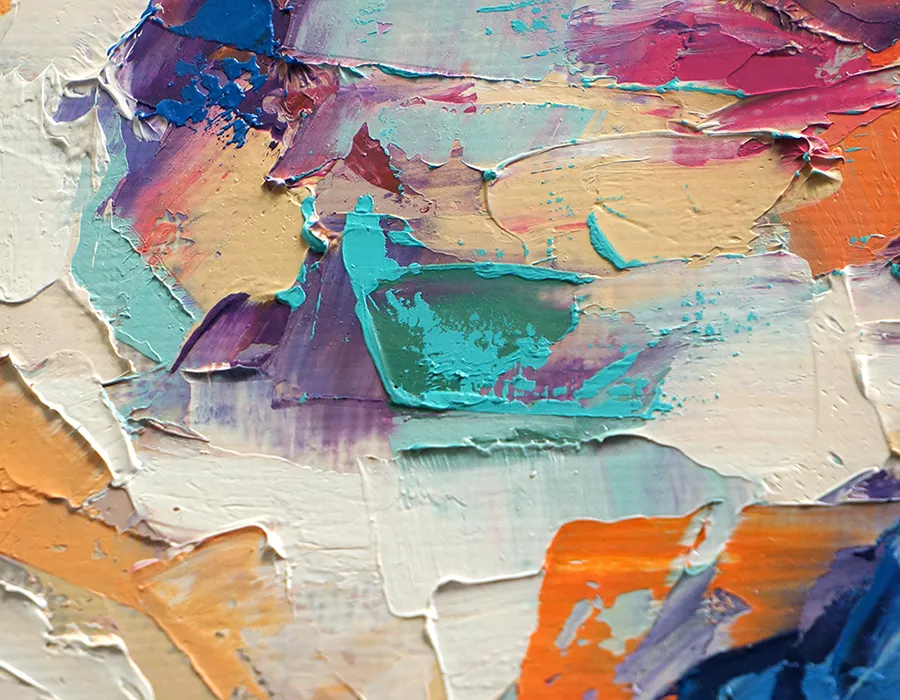
The birth of acrylic paints comes from a contamination with worlds that had little to do with painting: father and inventor of these colors was Otto Röhm, German pharmacist and chemist who became famous for studying, in the early twentieth century, a new enzymatic process to color the leather, with great benefit for the tanning industry. In 1915 he patented and brought on the market those lacquers and those paints that today we know as the ancestors of the tubes used for acrylic painting.
With the spread within the reach of all of these new colors began the artistic experimentation: some Mexican muralists decided to try them, not on a canvas, but on a wall! With exceptional results of intensity to brilliance and quick drying that allowed realization of large paintings.
David Alfaro Siqueiros took this concept of acrylic paint outside the borders of Mexico, with an exhibition workshop organized in New York in 1936 dedicated to acrylic painting.
A great Mexican painter and muralist, internationally known for his works of realism and already very famous, especially thanks to his works of high social impact, he was seen by the main exponents of a new American artistic current in full swing.
It was on that occasion that a very young Jackson Pollock first encountered acrylic paints, which he began to use in his very particular way, leaving them to run directly from the jar on the canvas.
In the meantime, the color created by Röhm, and started to industrial production with the seller Otto Haas, had already achieved success, counting almost 2,000 employees. His paints were mainly used to paint bright wall shades and objects.
Only in the fifties the production of acrylic paints specifically intended for the world of art started, and then to modern acrylic painting that we know today.
These were the years in which artists were gradually beginning to explore new ways to make art, giving rise to what in later years was called POP culture. From abstract expressionism to pop art, the artistic world was revolutionized from within, and to do so it exploited new materials. Among these, in fact, acrylic colors, central to the work of some artists such as Andy Warhol, Robert Motherwell, Bridget Riley, David Hockney, Helen Frankenthaler and Larry Poons.
In these new colors pop artists found the concrete possibility of recreating images with flat backgrounds and outlined and precise contours, that could overlap in a thousand layers, thus giving a new opportunity that no other type of color had been able to offer up until that moment.
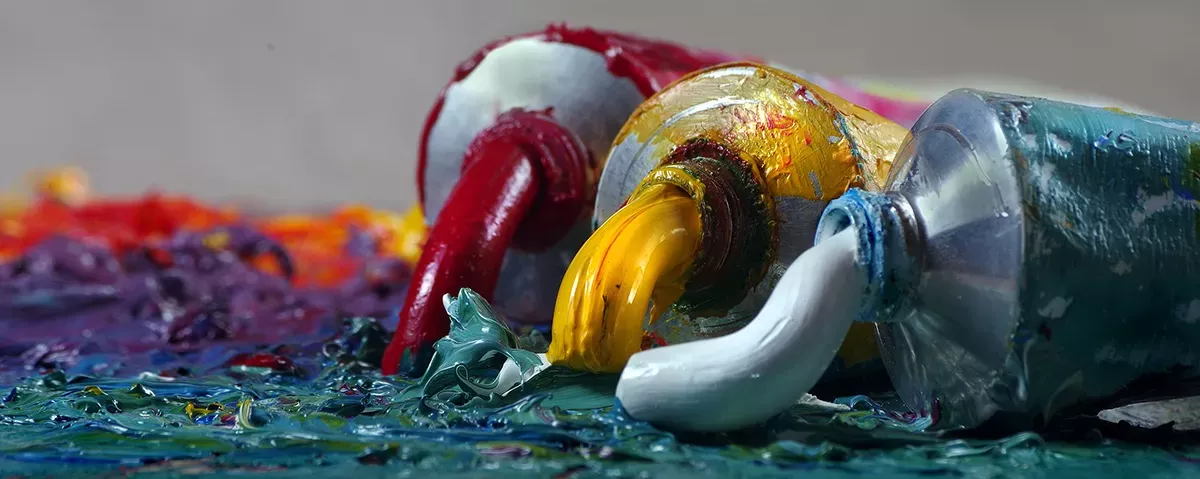
Painting with acrylic: acrylic painting
The acrylic color for painting is dense and pasty, and can have a matte or semi-glossy finish depending on the type of resin used for its composition. The dilution is done with water and also the cleaning of the instruments used.
Dries from the outside to the inside, creating a surface film in contact with the air. The drying is fast and for this reason it is generally worked by overlapping colors.
The greater the amount of water added to the color and the absorbency of the funds, the faster the drying (e.g. on untreated paper and wood). It is the most used family of colors for its extreme ductility: to paint, decorate furniture and walls, to paint on fabric. They tend not to need fixing (on absorbent surfaces) while on non-absorbent surfaces they must be protected with final paints to avoid stripping.
The basic composition is pigment conveyed and dispersed in acrylic resin: this type of composition and its ductility of use on all materials has attracted, over the years, many artists, thanks mainly to a short drying time, much lower than that of oil paints. The acrylic, once dry, are insoluble, permanent and flexible. With a composition very similar to the acrylic color, the chemical industry has created numerous MEDIUMS, gels and acrylic mortars that can change the appearance of both the material and finishing color, and even in the drying time.
Painting with acrylic: the composition of acrylic paints
The pigments at the base of acrylic paint are mixed with special polymeric resins, acrylic polymers, from which they take their name these very diffused colors.
Due to their particular composition, acrylic dyes do not require special thinners, but it is enough to use simple water. Also this feature plays in favor of acrylic paints, which can be used with appreciable results and with fun even by beginners of all ages.
Painting with acrylic: the acrylic pigment
Pigments are powders of various origin, organic or inorganic, which are found in nature or are created in chemical laboratories. They are the basis of all colors, because they have coloring power and the intensity of the tone obtained depends on the percentage dispersed in the binder.
Es. The pigment Terra di Siena is a powder that is obtained from the Sienese quarries, the blue of lapis lazulo was obtained by grinding the precious stones, while now it is created in the laboratory. They can be transparent or opaque and consequently the obtained color will have the same characteristics of the pigment.
The mixture to be stable over time is made with rollers and huge kneaders that work to make the mixture homogeneous and uniform, and usable by brush. The grinding of pigments made with rollers, creates extra fine and creamy colors, great for processing in painting.
Paint with acrylic: acrylic resin.
The chemical composition of acrylic resin is of polymers that are consolidated with the evaporation of the water contained inside. The structure thus obtained becomes solid, maintaining high characteristics of elasticity and is irreversible and insoluble! From a whitish matter we pass to a transparent film, characteristic for which the composed colors tend to darken in drying.
In the background the acrylic resin behaves like a glue: from white it turns into transparent, it clings to any surface, creating a film, but the need for absorbent funds to become permanent (such as paper, canvas, fabrics, walls) and is perfectly washable.
On non-absorbent substrates remains until the film colour is removed by «scraping» the surface. It is also perfect to include any type of inert material, from pigments to sand, up to small objects, thus becoming an incredible resource for material painting. We summarize some peculiarities and differences to shed light on the Mediums.
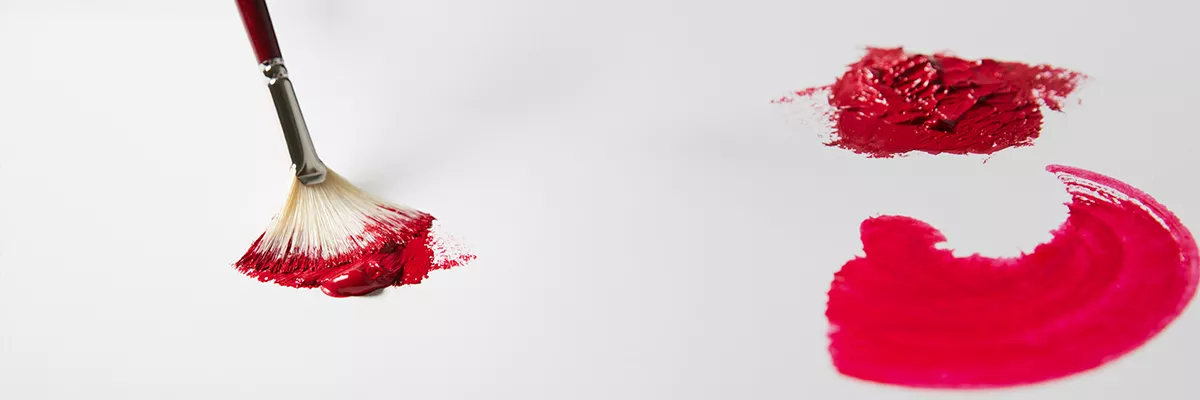
Painting with acrylic: the media for acrylic painting
Mediums are auxiliary products used to change the final appearance of acrylic. They are divided into 3 large groups: medium liquids, gels and mortars.
Liquid or medium medium
They are low density acrylic resins to which additives are added to change the final appearance of the acrylic color and its workability without altering the texture.
The mixing percentage should not exceed a threshold of 30% to prevent the color from becoming too fluid. They are worked with the brush both in the mixing and in the drafting.
The most used averages are:
- Medium retardant, which slows the drying of acrylic painting allowing wet on wet to create soft shades similar to those of oil. In very high doses it tends to dull the color.
- Medium Brilliant, makes all the colors with which it is mixed with a greater and uniform brilliance, always approaching the effect of oil painting. Given the ductility of the technique, a Opacifying Medium is also used, which makes all the shades opaque.
- Acrylic resin, is the very basis of the color and replaces water in thinning the color. It makes the color more transparent and liquid while maintaining the tone unchanged. It is used for veils in hyperrealistic effects.
Medium gel
Pure acrylic resins of medium density to which additives or thickeners are added, without any pigmentation, which transform the acrylic color from flat to 3D. When used pure, they tend to turn slightly yellow over time. They are worked both by brush and spatula, in mixing and in applying.
- Gel dense glossy- makes the color dense and shiny, suitable for processing to thickness and inclusions of material in transparency.
- Dense matte gel- makes the color dense and opaque, milky effect.
Le malte
High density acrylic resins mixed with a material that will give the final material effect to the acrylic color. They completely change the texture of the color and are applied and mixed mainly with spatula. Depending on the material inserted they will have completely different effects. Drying times become very long.
- Smooth mortar- contains marble powder and creates smooth and homogeneous thicknesses.
- Lightweight mortar- contains small hollow balls, creates high thicknesses without adding weight and remains extremely absorbent once dry.
- Sandblasted mortar- with pumice sands, makes the color grainy, looking rough wall.
- Decorative mortars- depending on the material they contain give the final appearance
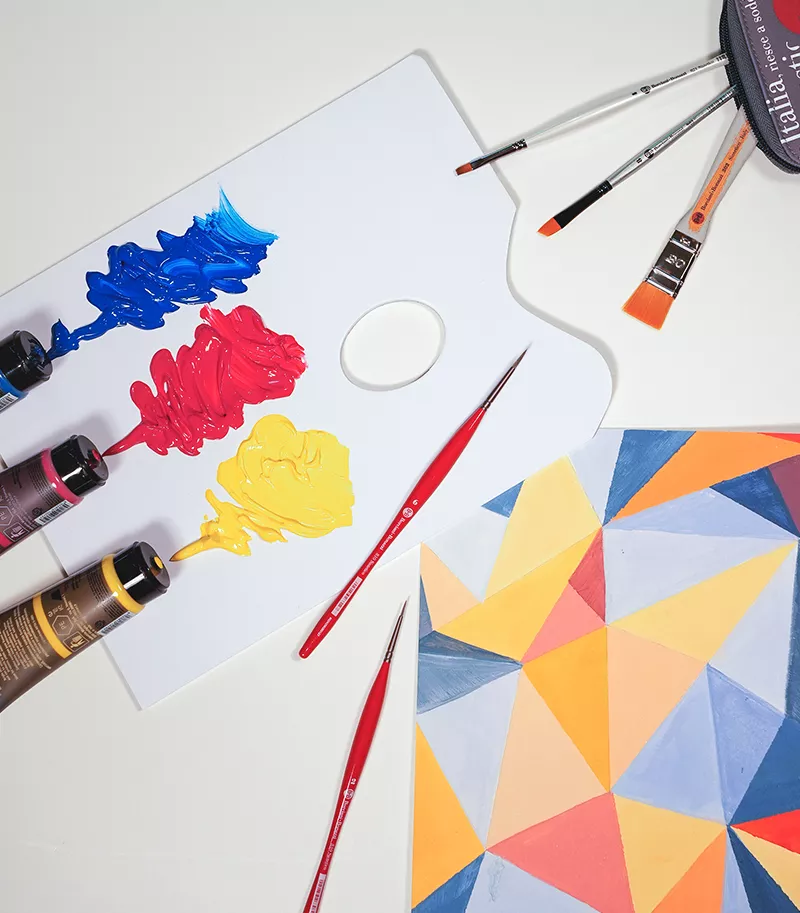
Painting with acrylic: 3 things to know to get started on the right foot
Extremely versatile, brilliant and easy to use: acrylic paints were for artists of the late twentieth century what the tubes of color were for the impressionists of the previous century.
They are perfectly mixed with each other and, starting from the packages with primary colors, white and black, you can get endless shades of shades.
1. Choose the right colors for painting with acrylic
When you start painting with acrylic paints the advice is to start with a small set of primary colors, with the addition of black and white. The practice of building colors by mixing various shades is a valuable help to improve your painting technique.
Starting with an endless selection of loose colors or with sets of many colors is not a good solution, especially if you are a beginner and want to start experimenting with this technique.
It is an extremely versatile type of painting, particularly suitable for beginners. The covering color rendering and its waterproofness once dry mean that you can work with many different painting techniques, starting from the darkest shades to get to the shades of light or vice versa, depending on the final effect you want to achieve.
At that point you can pass over the painted area with a second color without it mixing with the one below.
This does not mean that it is an "easy" painting: like all techniques requires commitment, constancy and a lot of exercise, and above all you must always keep in mind when working with acrylic paints that the drying time is reduced and very fast!
You can still use these colors to make acrylic paint to glaze, going to strongly dilute the dough with water or medium: you can use them as if they were watercolors or diluted oil painting, Each time forming new shades and depth effects extremely realistic.
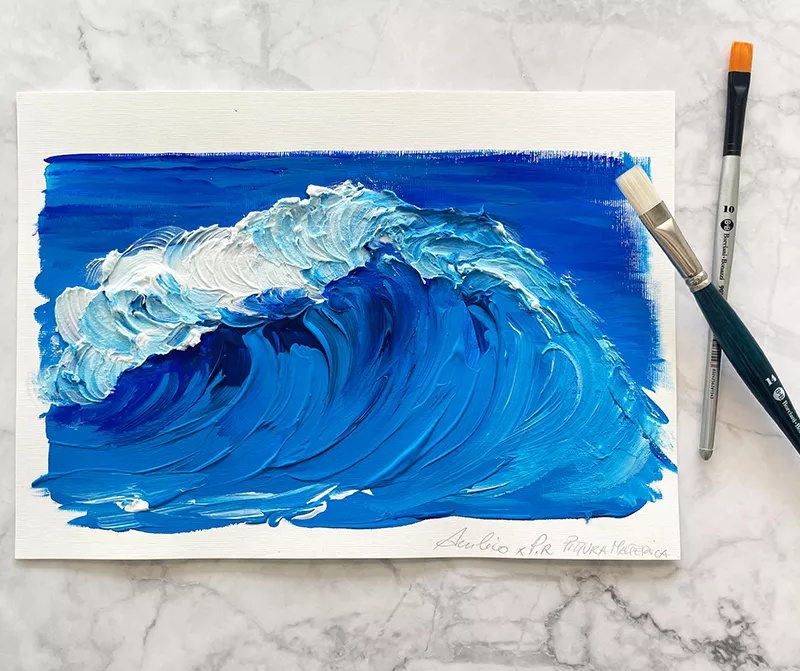
2. Choosing the right media for painting with acrylic
Acrylic paint is suitable for all media, from paper, cardboard, wall, canvas to non-absorbent materials such as treated wood, metal and glass.
For the characteristic drying from outside to inside, the acrylic color creates a kind of film that, in the absorbent media will penetrate into the bottom, and in the non-absorbent ones will stop on the surface, remaining adhesive until you proceed to scratch it from the base.
We can therefore say that acrylic is suitable for all media, it will be the finish or protective varnish to determine the durability.
3. Choose the right brushes to paint with acrylic
The dilution and cleaning of acrylic brushes is done only with water. Acrylic paints can be used with various types of brushes, natural or synthetic, according to the final effect that the artist aims in the painting and in his style.
All acrylic brushes that are used for tempera, gouache and watercolor, soft and absorbent, are suitable for smooth painting effects, with fine glazes and layers in diluted colour. For effects with a texture trace in a pasty color, whether or not mixed with gel or acrylic mortars, instead we will use more tenacious and rigid natural and synthetic fibers as for oil colors.
A small list can help in choosing the most suitable effect you are looking for.
For high thickness painting and strong material traces, you can use stainless steel spatulas of various shapes: chisel, knife, trowel or decorative, the spatulas act on the acrylic color and on the mediums with obvious and thick traces. Ideal in contemporary painting to create media mix effects.
The acrylic color lends itself to experiments and mixed uses, and the use of different tools to spread the color, such as pads or sponges, plastics and textured fabrics, according to the result sought, is perfectly plausible in the artistic research of each.
Starting with synthetic yarns we find:
- Brushes in Synthetic Fiber Gold and Fine Gold: they are very elastic, thin and do not leave traces in the painting. Ideal especially with brushstrokes, for applying funds and flat backgrounds in full color.
Product Codes: #302 #203 - Unico Silver synthetic fiber brushes: thick Silver fibre is hollow, similar to a micro cannula, with high elasticity and leaves traces in the pasty acrylic color, creating the characteristic ridges of the painting. Ideal for working even on rough and difficult surfaces, such as walls, where the stretch must be precise and continuous.
Product Codes: #810 #811 #812 - Dark red-violet synthetic fiber brushes: elastic and tenacious fibre that can move the acrylic color even mixed with gel and thick mortars. Ideal for layouts and defined strokes and with the obvious track.
Product Codes: #1 #2 #3 #4 #6 #6/C #310 #600 #601 #604
If the choice falls on natural fibers you can choose:
- Bristle brushes: made of natural hair, they are rigid with low absorbency of colour and leave their mark in the acrylic colour typical of expressionist painting. Very resistant to wear, they are the brushes commonly used also for oil-paste painting.
Product Codes: #200F #208 #303 #50 #51 #52 #55 #47 #45 - Ox hair brushes: in natural Ox hair are perhaps the most used brushes since ever. Characterized by an extreme softness and a good release of water and absorbency color; ideal for low elasticity and thin hair to acrylic painting, watercolor gouache and oil. The brush stroke is soft and light, the track is delicate and used especially for veils and shades.
Product Codes: #70 #71 #71/C #72 #72/c #75 #76 #77 #78 #79 #205 - Sable brushes: in natural fur of Sable of the Musteridae family, which lives mainly in forest areas. Widespread in almost all the north, it is divided into various species depending on the origin. Its precious fur, with characteristics of elasticity and high absorbency of color is used for various techniques, from acrylic to watercolor to oil painting. The strokes are defined, soft and resistant. Ideal for precise details and lines, without leaving any material traces in the color.
Product Codes: #100 #101 #102 #102/C #105 #106 #107 #111 #112 #113 #114 #115 #204






























